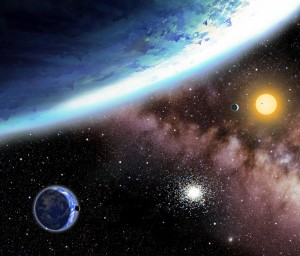Astronomers find most Earth-like planets yet

This undated handout artist concept provided by Harvard Smithsonian Center for Astrophysics shows the newly discovered planets named Kepler-62e and -f. Scientists using NASA’s Kepler telescope have found two distant planets that are in the right place and are the right size for potential life. This handout image from Harvard-Smithsonian Center for Astrophysics shows an artist concept of what these two planets, called Kepler-62-e and Kepler-62-f look like. The larger planet in the left corner is somewhat covered by ice and is f, which is farther from the star. The planet below it is e, which is slightly warmer and has clouds and may be a water world. AP PHOTO/HARVARD SMITHSONIAN CENTER FOR ASTROPHYSICS
WASHINGTON—Using a potent NASA space telescope to scan the skies for planets like ours where life might exist, astronomers said Thursday they have found the most Earth-like candidates yet.
Two of the five planets orbiting a sun-like star called Kepler-62 are squarely in what astronomers call the habitable zone—not too hot, not too cold and possibly bearing water, researchers said in the journal Science.
“These two are our best candidates that might be habitable,” said William Borucki, Kepler science principal investigator at NASA’s Ames Research Center.
The two planets are slightly larger than ours, and at least a couple of billion years older.
The first, 62e, is about 40 percent larger than Earth.
It might be warm, maybe even a waterworld, and may experience flashes of lightning, said Borucki.
The second, 62f, is about 60 percent larger than our planet, and orbits its star every 267 days, close to Earth’s annual trajectory of 365 days.
The planet may have polar caps, significant land masses and liquid water, Borucki said.
Both are orbiting a seven-billion-year-old star some 1,200 light years from Earth in the constellation Lyra.
They are close enough to their star to be warm, but not so near as to boil the oceans. They are far enough to maintain the likelihood of water without freezing the seas solid, Borucki explained.
Scientists do not yet know if their surfaces are rocky or watery, or if they have atmospheres that could sustain life.
But their location and size suggest they “could plausibly be composed of condensable compounds and be solid, either as a dry, rocky super-Earth or one composed of a significant amount of water,” said the study.
Other studies have indicated that planets with a radius under 1.6 times that of the Earth, like these two, “have been found to have densities indicative of a rocky composition.”
Astronomers detected the planets by observing their star dim when the planets pass in front of it, in what is known as a “transit.”
“These are the most similar objects to Earth that we have found yet,” said Justin Crepp, assistant professor of physics at the University of Notre Dame.
Crepp first saw a dot near Kepler-62 about a year ago, and has studied the movements of the system for months in order to confirm the discovery.
A third potentially habitable planet, Kepler 69c, is on the “inner edge of what has been considered to be the habitable zone,” said Thomas Barclay, Kepler scientist at the Bay Area Environmental Research Institute in Sonoma, California.
However, that one may be small and hot and more like Venus, the second planet from our sun, said Barclay, whose research was published Thursday in the Astrophysical Journal.
“We’re not sure yet,” he told reporters. Its host star, Kepler 69, is about 2,700 light years from Earth in the constellation Cygnus.
All together, the latest findings add seven new planets—four of which are outside the habitable zone—to the tally that Kepler has found so far, totaling more than 2,700 candidates and confirmed planets.
In late 2011, NASA confirmed its first-ever planet in a habitable zone outside our solar system—Kepler 22b, spinning around its star some 600 light years away.
However, the large size of that exoplanet, at 2.4 times the size of the Earth, has left some doubt over whether the planet is rocky, gaseous or liquid.
Another large planet that Kepler has confirmed in the habitable zone, Kepler 47c, is also much bigger than Earth.
Kepler, launched in 2009, is NASA’s first mission in search of Earth-like planets orbiting suns similar to ours.
It is equipped with the largest camera ever sent into space in its search for planets as small as Earth, including those orbiting stars in a warm, habitable zone where liquid water could exist on the surface of the planet.—Kerry Sheridan